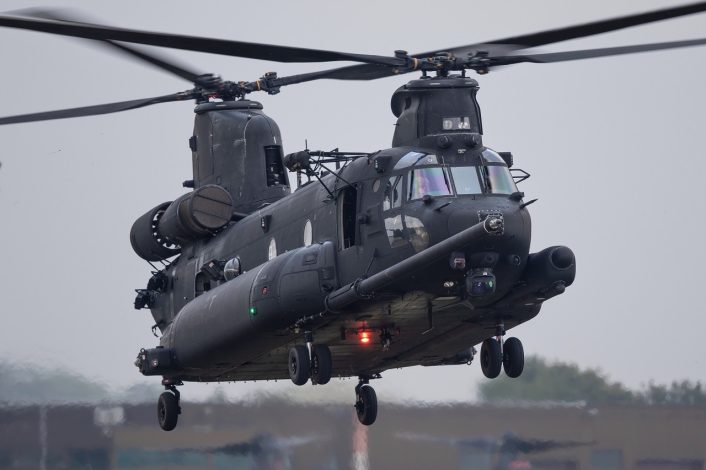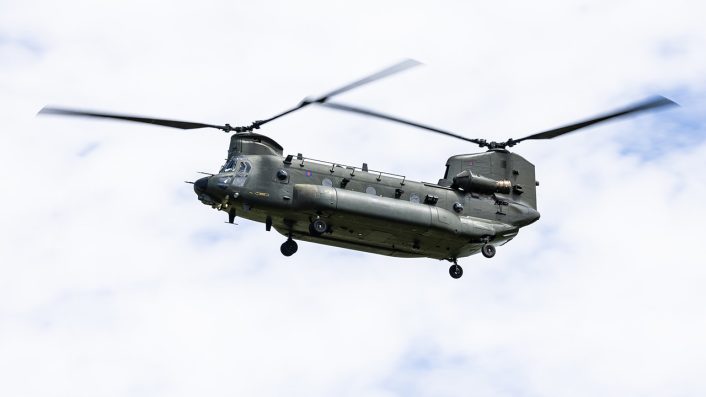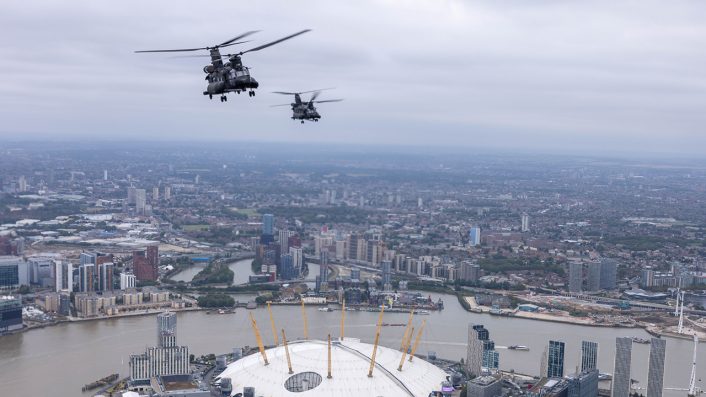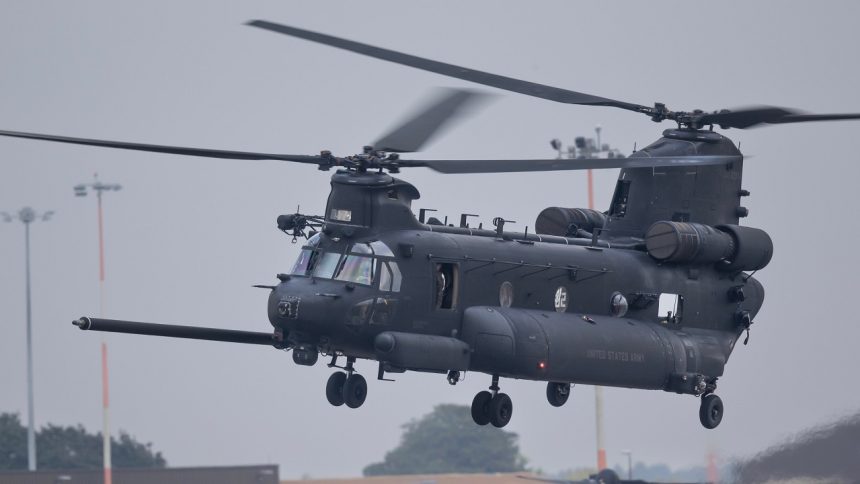Two MH-47G Chinooks from the U.S. Army’s elite 160th Special Operations Aviation Regiment have made a rare deployment to the United Kingdom to take part in joint training with British forces.
Arriving from Hunter Army Airfield, Georgia into RAF Mildenhall on board U.S. Air Force C-17A Globemaster IIIs on Sept. 3, 2024, the appearance of these very distinctive helicopters on British soil immediately attracted the interest of the strong aviation enthusiast community in the country.
The MH-47 is a highly modified special operations variant of the ubiquitous Boeing CH-47 Chinook operated exclusively by the 160th Special Operations Aviation Regiment (SOAR). Sporting the unit’s famous black paint scheme, an in-flight refueling probe, and a plethora of sensors, defensive aids and antennas, the Night Stalkers’ Chinooks have taken part in a number of legendary high stakes special operations missions. They are known to have supported secretive stealth Black Hawks during Operation Neptune Spear, the 2011 raid on Osama bin Laden’s compound.
Despite operating a fleet thought to be in excess of 70 MH-47s, which alone is greater in number than the entire Chinook fleet of the UK’s armed forces (the second largest operator of the type after the United States), the 160th’s high operational and training tempos as well as the discreet requirements of special operations make these helicopters a very rare sight in Europe. Many are likely to have passed through European bases in cargo aircraft on their way to operations in the Middle East, but these would appear to be the first to actually be unloaded.

The two airframes deployed to the UK, serial numbers 19-02914 and 19-02918, have been taking part in Exercise Dark Lightning. Based at RAF Odiham in Hampshire, home of the Royal Air Force’s Chinook fleet, the exercise focuses on interoperability between the two nations’ forces. Specifically involved on the UK side is No. 7 Squadron, Royal Air Force, which forms the Chinook component of the Joint Special Forces Aviation Wing.
On Sept. 9, in cooperation with the UK 7th SOS, elements of the 160th Special Operations Aviation Regiment (Airborne), conducted a flyover in Chinooks along London’s Heli-Lanes as part of interoperability exercise Dark Lightning 24. @USAinUK @RoyalAirForce pic.twitter.com/oGDJALDjQ7
— US Spec Ops Europe (@US_SOCEUR) September 10, 2024
This unit would therefore be among the most likely of units to operate alongside 160th SOAR Chinooks in an operational environment. Other parts of the UK Special Forces (UKSF) umbrella, such as the Special Air Service (SAS) and Special Boat Service (SBS), are almost certain to have joined with these exercises, but the UK Ministry of Defence normally refrains from commenting on matters regarding these units.
While operating from Odiham, the Night Stalkers spent time operating over the famous Salisbury Plain Training Area (SPTA). SPTA has been used for military exercises since 1898 and is the UK’s largest military training range, taking up 150 square miles and accounting for 11% of the entire county of Wiltshire, plus part of Hampshire. Not all of the site is closed to the public, with some areas allowing a close look at ongoing training.
Another fantastic day with the US Army @160th_soar MH-47G’s from @usasoac the Night Stalkers on #SPTA Deptford Down, accompanied by our own 7 Sqn #chinook from @RAF_Odiham 🤘 pic.twitter.com/DKIsnGuTwg
— Mark Youd (@MarkYoud2) September 12, 2024
In addition to working with UK forces, the Night Stalkers have trained with fellow U.S. forces permanently stationed in the UK. On Sept. 18 a MC-130J Commando II from the 67th Special Operations Squadron at RAF Mildenhall was spotted by aviation enthusiasts refueling both MH-47Gs simultaneously from its wing refueling pods over North West England. During a stay in Scotland at Leuchars Station, formerly RAF Leuchars, the 160th SOAR were also afforded the opportunity to train with visiting Spanish NH90s.
These are most definitely ‘record shots’. All taken from Dundee. US Army MH-47G Chinooks and Spanish Army NH.90s. Pleased to get them. pic.twitter.com/jb1uLVDUHQ
— Dundee Birding (stonefaction) (@SFbirding) September 18, 2024
After concluding their trip to Scotland, the U.S. Chinooks returned to Odiham on Friday Sept. 20, and appear to have taken the following weekend as rest days after a very busy two weeks of flying.
British Special Ops Chinooks in the pipeline?
Under current plans, the UK intends to procure fourteen new Chinooks of a variant officially referred to as H-47(ER). These will have larger fuel tanks over standard Chinooks and are said to have the in-flight refueling capability boasted by the MH-47G. For this reason, they are thought to be intended primarily for UKSF use, and could be outfitted similarly to the Night Stalkers’ aircraft. This would mean Exercise Dark Lightning could additionally be providing some familiarisation training for UK forces with this special operations platform.
H-47(ER) would not be the UK’s first foray into special operations Chinooks. In the 1990s the Chinook HC3 was ordered, modeled on the MH-47E variant then used by 160th SOAR but pared back to save costs. These aircraft featured the distinctive ‘fat’ fuel tanks, upgraded avionics and additional equipment for low level night operations. Unfortunately, issues with these avionics prevented the aircraft from being signed off for service. Despite being delivered in 2001, the first Chinook HC3 to fly did not lift from the ground until 2009, after a ‘reversion’ program to align them with the Chinook HC2’s avionics fit. The then Chair of the House of Commons Public Accounts Committee described the Chinook HC3 as “one of the most incompetent procurements of all time”.
Now upgraded with new avionics (which were installed fleet wide) the eight Chinook HC3s have been re-designated Chinook HC5 and continue to serve in the Royal Air Force, albeit lacking most of their unique features except the expanded fuel tanks.

Changing with the times
While famous for their black helicopters, the 160th SOAR have recently been spotted trialing new camouflage schemes adapted for specific operating environments. These schemes, based on U.S. Army documentation, appear to be applied using temporary wraps, almost like those frequently used in the automotive industry. A striking maritime-focused blue camo has been spotted on the Regiment’s MH-6M Little Birds and MH-60M Black Hawks, while the latter has also been seen with a predominantly white arctic version.
160th SOAR MH-6M “Little Birds” rocking the blue camo 😎 pic.twitter.com/OPj5mS8FTY
— Thenewarea51 (@thenewarea51) June 20, 2024
So far, these wraps have not, as far as reports go, been publicly sighted on the unit’s Chinooks, but they have taken part in increasingly public training operations in the maritime domain. Combined with fears of future confrontations in the Pacific Ocean, perhaps the blue camouflage will soon make its way onto this type also.










